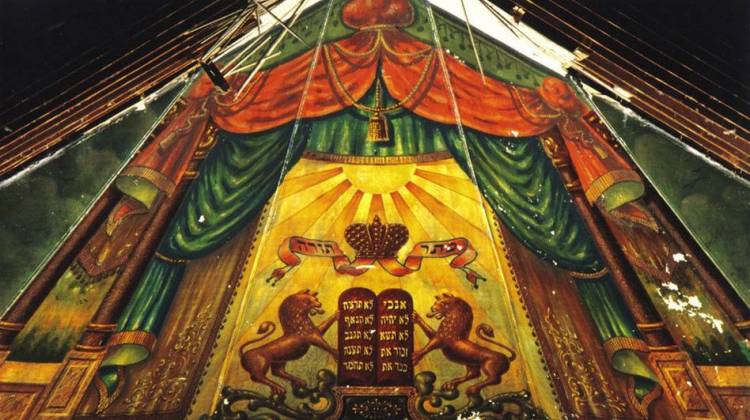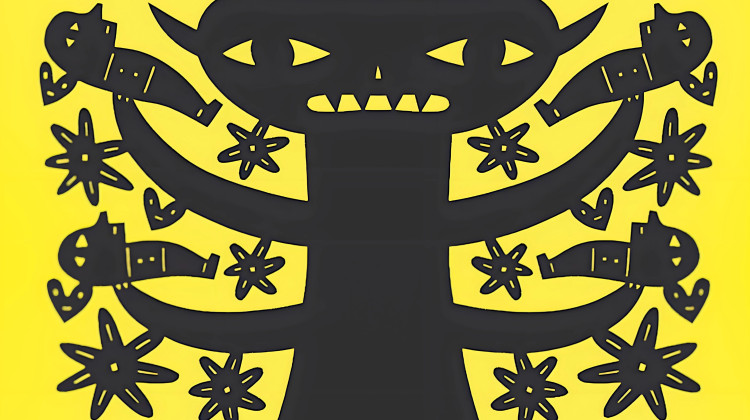There was a time in Eastern Europe when the landscape was dotted with wooden synagogues, some dating to the 1600s. Inside, the walls and ceilings were covered with intricate painted designs. Almost all of these structures were destroyed during the Holocaust, and with them a folk art. But in Burlington, Vt., a synagogue mural has been uncovered where it lay hidden for a quarter century.
Aaron Goldberg grew up in a section of Burlington known as Little Jerusalem. His family was among the Jewish immigrants who settled there in the late 1800s, mostly from Lithuania. Goldberg first saw the mural in the 1970s when he was in middle school and accompanied his mother to a carpet store.
"I have a distinct memory of going up to the second floor to look at the carpet rolls and the remnants with my mother and seeing a painting on the back wall," he says. "It was surreal."
The store, it turned out, had once been a synagogue. Shoppers could see rays of sunlight, a crown hovering above a tablet with the Ten Commandments and a throne supported by two lions of Judah — all part of a mural stretching 10 feet high and 18 feet wide. It had been painted in 1910 by an immigrant artist named Ben Zion Black.
Years later, Goldberg and another member of his synagogue learned that the carpet store had been sold and the new owner was going to convert the building into apartments.
"She allowed us about a month to see if we could figure out a plan to get the mural out," he says. "So we called museums, hospitals, colleges, commercial warehouse storage spaces all over the East Coast and we could not locate a space. So we asked her if she would consider walling up the mural."
The owner agreed and for 25 years tenants lived in an apartment not knowing what was behind the walls.
An Exuberant Work Of Art
Two years ago, the Ohavi Zedek Synagogue, where Goldberg serves as archivist, started renting the apartment. It tore down the wall that had been erected to protect the mural and hired art conservator Connie Silver to help restore it.
"This is a really exuberant work of art," she says.
Silver is living in the apartment while she removes a century's worth of grime that accumulated on the mural. Chemical analysis revealed that the mural was covered with an oily varnish to preserve it.
Silver sprays the mural with a special adhesive that bonds the paint to the plaster wall, then dabs at it with scraps of Mylar to press the fragile paint back onto the wall. She says the colors of the mural have been dulled substantially.
"It's going from this kind of golden, unpleasant brown to pistachio green next to bright gold color," Silver says. "This is really a startling change and I was even a little confused because I've never seen these sorts of exuberant colors."
The mural is attached to the wall and part of the roof. At some point, a 3,000-pound hunk of the building will be cut out and moved to the Ohavi Zedek Synagogue less than a mile away.
A Document Of A Jewish Civilization
"I've never confronted, never seen a mural of this type that survives and can be saved," says Samuel Gruber, an architectural historian at Syracuse University. He says the Burlington mural is a valuable artifact because it's a form of folk art no longer being created.
"This is a document of a Jewish civilization, a Jewish culture, a Jewish tradition in art that was vibrant and widespread and accomplished, but today has almost entirely vanished," he says. "It was destroyed in the Holocaust. It's a survivor and for that reason I think we have a special obligation. We have to save it and move it. We have to give it a new life."
If the Ohavi Zedek Synagogue can raise $100,000 in the next couple of months, it hopes to move the mural by the end of the summer. It will be tricky, though: A huge forklift — the kind used to move boats — will transport the artwork. Cleaning and restoration work will be completed after the mural is installed in the synagogue's lobby.
9(MDEwMDc1MzM3MDEzNDczOTA0MDc1MzViMQ001))
 DONATE
DONATE









 View More Articles
View More Articles


 Support WFYI. We can't do it without you.
Support WFYI. We can't do it without you.